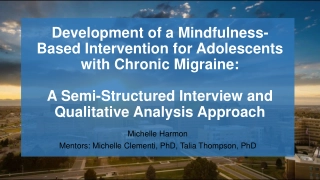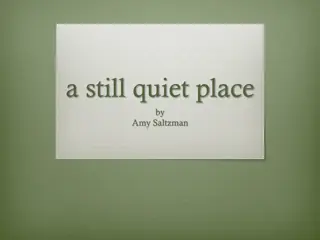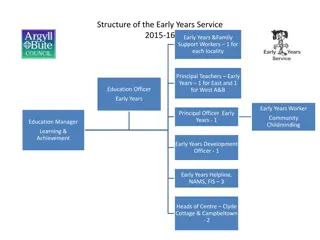Understanding Mindfulness in Early Years Education
Delve into the concept of mindfulness in early childhood education, exploring its benefits, techniques, and practical applications within educational settings. Discover how mindfulness fosters awareness, attention, and well-being in young children, supported by research findings on cognitive and social-emotional development. Embrace mindfulness as a holistic approach to nurturing children's mental health and enhancing their learning experiences.
Download Presentation

Please find below an Image/Link to download the presentation.
The content on the website is provided AS IS for your information and personal use only. It may not be sold, licensed, or shared on other websites without obtaining consent from the author. Download presentation by click this link. If you encounter any issues during the download, it is possible that the publisher has removed the file from their server.
E N D
Presentation Transcript
MINDFULNESS IN THE EARLY YEARS Tameside Educational Psychology Beth Shaw Erica Douglas-Osborn
WHAT IS ON YOUR MIND? Think of something that is on your mind; write it down; screw it up / rip it up and throw it away and relax and enjoy the session
AIMS To understand what mindfulness includes. To understand some of the benefits of using mindfulness with young children. To practice some mindfulness techniques for young children. To identify and discuss how mindfulness could be used within Early Years settings or as an EP working with young children.
GROUP AGREEMENT Respect each other Trust/ Confidentiality Make sure everyone gets a chance to speak Be responsible for getting your needs met Be willing to experiment Bring and share your ideas Only join in with what you feel comfortable with Check in afterwards if needed
WHAT IS MINDFULNESS? Mindfulness refers to the awareness that emerges through paying attention on purpose, in the present moment and non-judgementally to the unfolding experience moment by moment (Kabat-Zinn, 2003 p.145)
FEATURES OF MINDFULNESS Attention to the present moment Beginner s mind Awareness Trust Self-compassion Non-striving Non-judgement Acceptance Patience Letting go
HOW ARE YOU MINDFUL? What do you do in your daily lives whereby you may be practicing mindfulness (consciously or unconsciously)? How could you be more mindful? It is really important to practice being mindful in order to teach it.
MINDFULNESS IN SCHOOLS/ ORGANISATIONS Recognised by NICE and is increasingly used in preventative and well-being programmes Ofsted Framework (2015)- schools have a duty to support children s well-being and mental health. Recent large scale systematic literature review (Maynard et al., 2017) indicates benefits to children s cognitive skills (e.g. executive function, memory, attention) and social-emotional wellbeing (e.g. reductions in anxiety, stress, internalizing behaviours, improved social skills, self-regulation, self-esteem and engagement).
MINDFULNESS IN THE EARLY YEARS Growing attention in terms of using mindfulness in the Early Years (Kindness Curriculum). Research demonstrates increasing numbers of children with attention difficulties at a young age (DiCarlo et al., 2016; Rabiner, Godwin & Dodge, 2016). Children with attention and listening difficulties are often at risk of poorer outcomes. Case study using mindfulness in a nursery and reception class found that staff reported the children to be calmer and more ready to learn (Holt, Atkinson, Douglas-Osborn, 2019). A preliminary study carried out with 21 preschool children, assigned randomly to either a group accessing mindfulness or a control group, showed significant improvements in prosocial behaviour, including improvements in self-regulation. (Berti & Cigala, 2020) Meta-analysis of 21 studies focussing on 3- to 12-year old children showed that teacher reports suggest a significant improvement in children s overall inattentive and hyperactive-impulsive behaviour following mindfulness- based interventions. (Vekety, Logemann & Takacs, 2021)
SETTING THE SCENE When supporting EY settings to think about developing mindfulness, need to think about: Developing a theme sign / picture / visual reference / music / mindfulness buddy Developing a routine how many times a day / when / where / how to start? Being flexible
MINDFULNESS ACTIVITIES 1. Teaching about breath 2. Guided imagery BURY EDUCATIONAL PSYCHOLOGY SERVICE
TEACHING ABOUT THE BREATH What is breath? How could we teach this?
TEACHING ABOUT THE BREATH Use of the hand Blowing windmills Blowing bubbles Rainbow/finger breathing Use of scripts vs making it up
TEACHING ABOUT THE BREATH Breathe on the hands Everyone sit comfortably on your bottoms. Let s get ready for mindfulness. Bring your hands up to your mouth You should see the tops of your fingers (children may need further prompting about where to place their hands so they are in front of their mouths) Slowly open your mouth and blow Breathe in and blow out Breathe in and blow out Feel your hands get warm ** Slowly put your hands back on your knees. 1b. **Add (once children have got used to breathing onto their hands you can extend the activity): Blow a big breath Feel as your hands get warmer They might feel hot Then they might feel cold Then they might feel hot
TEACHING ABOUT THE BREATH Rainbow breathing Everyone sit comfortably on your bottoms. Let s get ready for mindfulness. Put your hands together Breathe in Lift your hands together in the air Breathe out Make a rainbow with your hands Put your hands together Breathe in Lift your hands together in the air Breathe out Make a rainbow with your hands (Can do this as many times as works well) Slowly put your hands down onto your knees.
GUIDED IMAGERY Short stories which create imagery use of movement (to support children s engagement). Add to existing structure breathing activities then guided imagery.
WRITING GUIDED IMAGERY Chose a topic that a child/the children may like can link to the curriculum Make it short and use simple language (use language that you are comfortable with) Include movement Add additional stimulus, e.g. picture on the whiteboard/sound/smell/related objects Practice your scripts Have a consistent way of introducing your imagery and in ending it
READING GUIDED IMAGERY Take a deep breath - make sure that you are feeling calm and relaxed. Tune in where possible to the child/children working with- recognise their mood. Sometimes start louder or faster and get slower to support the class to calm down. Leave spaces between your words to give the child/children some time. Speak very slowly, put a slow, calm rhythm to your voice. (It may be helpful to practice) Model any breathing and movements to the child/children in order to show them what to do. Enjoy it!
SUNSHINE Everyone sit comfortably on your bottoms. 5 4 3 2 1 Breathe in and out, in and out, we are going on a sunshine adventure. Pretend you are outside. It is a lovely day. The sun is shining. Lift your hands up and touch the shining sun. Stretch up high. Touch the sun. Bring your hands back down. Lift your hands up and touch the shining sun. Stretch up high. Touch the sun. Bring your hands back down. Lift your hands up and touch the shining sun Stretch up high. Touch the sun. Bring your hands back down. Your body feels warm from the shinning sun. Let s say goodbye sun. Let s go back to our calm, quiet, warm classroom. 5 4 3 2 1
ACTION PLANNING What might you do next following this session? When are you going to start? Who is going to help you? What might you do first?
BODY SCAN Lying down breathing Everyone lie down comfortably on the floor. Let s get ready for mindfulness. Take a big breath in and out, in and out. Feel your toes, breathe in and out. Feel your feet, breathe in and out. Feel your legs, breathe in and out. Feel your bottom, breathe in and out. Feel your tummy, breathe in and out. Feel your chest, breathe in and out. Feel your fingers, breathe in and out. Feel your hands, breathe in and out. Feel your arms, breathe in and out. Feel your face, breathe in and out. Feel your head, breathe in and out. Feel your body, breathe in and out, in and out. Slowly sit up onto your bottom.
THANK YOU FOR LISTENING Erica Douglas-Osborn Erica.Douglas- Osborn@Tameside.gov.uk Beth Shaw Beth.Shaw@Tameside.gov.uk Mindfulness in the Early Years Book: Mindfulness in the Early Years : Douglas-Osborn, Erica: Amazon.co.uk: Books























